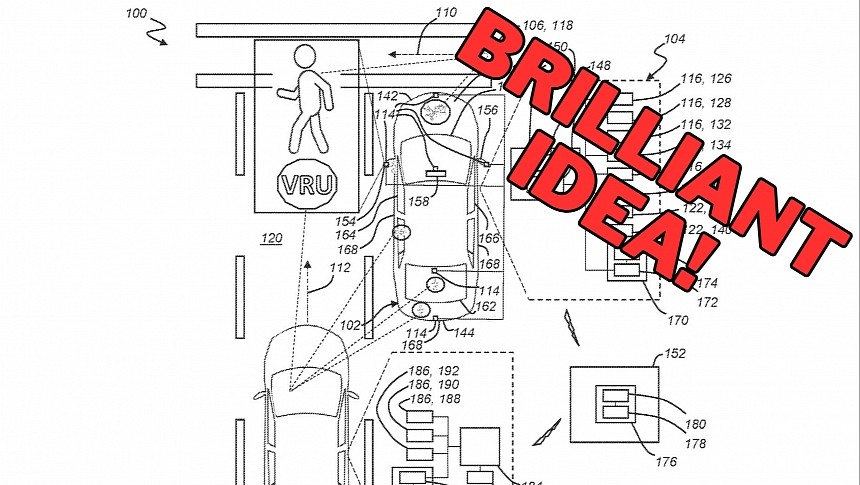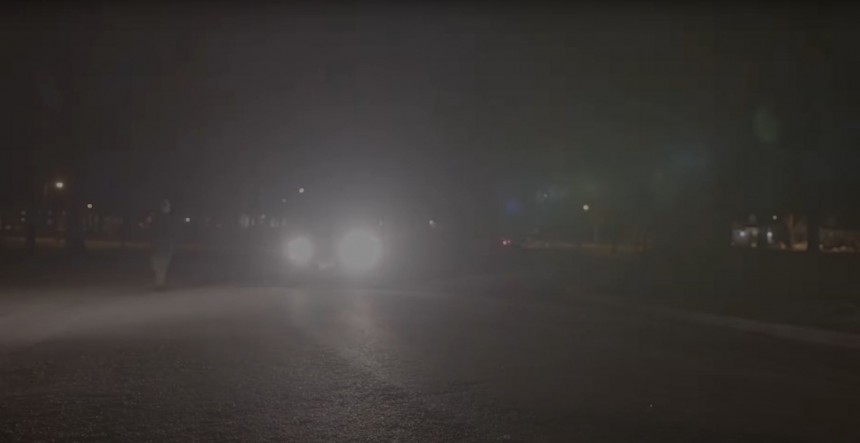General Motors has recently patented a new safety system that would allow its cars to communicate with the other vehicles on the road and warn them about a potential collision with a pedestrian.
The warning would be offered in the form of a visible and audible notification on the dashboard, giving drivers extra time to slow down and avoid the impact.
General Motors actually comes up with some very good suggestions when it's not trying to kill off very popular car technology. This latest patent, which covers a technology called the "cross-traffic warning system of a motor vehicle," is a brilliant concept that would help reduce the severity of an accident or even avoid it completely.
General Motors explains in the patent documents that the main goal is to allow vehicles to detect so-called Vulnerable Road Users in a timely manner, giving drivers more time to react.
The company describes the horrible scenario that all drivers are probably afraid of. A pedestrian jumps in front of a car, trying to cross the street. The first driver sees them, slams on the brakes to avoid the accident, and the pedestrian continues their attempt to cross the street. A second vehicle traveling in the next line can't see the pedestrian and doesn't slow down, eventually leading to an unavoidable collision that can prove to be fatal.
GM admits that today's cars are fitted with systems supposed to detect pedestrians and provide warnings to the drivers, but in such a scenario, they often prove useless, as they don't offer enough reaction time.
This is why the company now proposes a different approach.
Its new technology is based on a concept that has been around for quite some time. The vehicle-to-vehicle communications would allow for a car to warn another car that a pedestrian is on the side of the road. As General Motors described them, the Vulnerable Road Users can be anyone from a pedestrian to a roadway worker or an individual operating a wheelchair.
In any case, the cars on the road must be aware of their presence, and the only way to do this is to allow a vehicle to warn the other vehicles about it.
Without getting too deep into technical details, General Motors explains that vehicles must be equipped with transmitters and signal receivers to be able to communicate efficiently. Using the onboard sensors and systems, including pedestrian detection technology, a vehicle traveling in one lane can detect the Vulnerable Road User.
As I said, this vehicle can already react accordingly using the embedded safety systems. In some cases, it can engage the brakes and bring the vehicle to a halt to avoid a collision, but the bigger concern, in this case, is the car traveling in the next lane.
As a result, General Motors says the first vehicle that detects the pedestrian must send a warning to the other vehicles nearby. The warning can be an audio notification, a visual alert on the dashboard, or both. In more advanced implementations, the system can also automatically activate collision avoidance systems, allowing the vehicle to slow down before the driver themselves press the brakes.
This technology would obviously fit autonomous vehicles like a glove. It can determine the likelihood of an accident depending on the current speed, direction, and other factors, eventually allowing the vehicle to take proper action. Depending on the collision mitigation systems available on the car, the system can apply the brakes or adjust the traveling path to avoid pedestrians. Eventually, the system can be further updated with other features in order to make it more efficient and help avoid or reduce the severity of a collision.
The technology is still in the patent phase, but considering that almost all the required hardware is already on production models, it should all be just a matter of time until it gets the green light for future cars.
The only problem is creating a universal system that would be available not just on GM's vehicles but on all models out there. Vehicle-to-vehicle communications have long been a revolutionary concept, but its adoption is happening at a slow pace, particularly due to the interoperability problems between carmakers. The only ones that could help tackle this issue are government regulators, as they could adopt new legislation to make such technology mandatory on production models. And given autonomous vehicles rapidly make their way to production, it's probably just a matter of time until this happens anyway.
You can check out GM's patent in full in the box after the jump, but keep in mind it's just a proposal for now. General Motors has something else to stay busy these days, as the company will kill off Android Auto and CarPlay in its cars, going all-in on Android Automotive. The model that'll spearhead the switch is the 2024 Blazer EV.
General Motors actually comes up with some very good suggestions when it's not trying to kill off very popular car technology. This latest patent, which covers a technology called the "cross-traffic warning system of a motor vehicle," is a brilliant concept that would help reduce the severity of an accident or even avoid it completely.
General Motors explains in the patent documents that the main goal is to allow vehicles to detect so-called Vulnerable Road Users in a timely manner, giving drivers more time to react.
The company describes the horrible scenario that all drivers are probably afraid of. A pedestrian jumps in front of a car, trying to cross the street. The first driver sees them, slams on the brakes to avoid the accident, and the pedestrian continues their attempt to cross the street. A second vehicle traveling in the next line can't see the pedestrian and doesn't slow down, eventually leading to an unavoidable collision that can prove to be fatal.
GM admits that today's cars are fitted with systems supposed to detect pedestrians and provide warnings to the drivers, but in such a scenario, they often prove useless, as they don't offer enough reaction time.
This is why the company now proposes a different approach.
In any case, the cars on the road must be aware of their presence, and the only way to do this is to allow a vehicle to warn the other vehicles about it.
Without getting too deep into technical details, General Motors explains that vehicles must be equipped with transmitters and signal receivers to be able to communicate efficiently. Using the onboard sensors and systems, including pedestrian detection technology, a vehicle traveling in one lane can detect the Vulnerable Road User.
As I said, this vehicle can already react accordingly using the embedded safety systems. In some cases, it can engage the brakes and bring the vehicle to a halt to avoid a collision, but the bigger concern, in this case, is the car traveling in the next lane.
As a result, General Motors says the first vehicle that detects the pedestrian must send a warning to the other vehicles nearby. The warning can be an audio notification, a visual alert on the dashboard, or both. In more advanced implementations, the system can also automatically activate collision avoidance systems, allowing the vehicle to slow down before the driver themselves press the brakes.
The technology is still in the patent phase, but considering that almost all the required hardware is already on production models, it should all be just a matter of time until it gets the green light for future cars.
The only problem is creating a universal system that would be available not just on GM's vehicles but on all models out there. Vehicle-to-vehicle communications have long been a revolutionary concept, but its adoption is happening at a slow pace, particularly due to the interoperability problems between carmakers. The only ones that could help tackle this issue are government regulators, as they could adopt new legislation to make such technology mandatory on production models. And given autonomous vehicles rapidly make their way to production, it's probably just a matter of time until this happens anyway.
You can check out GM's patent in full in the box after the jump, but keep in mind it's just a proposal for now. General Motors has something else to stay busy these days, as the company will kill off Android Auto and CarPlay in its cars, going all-in on Android Automotive. The model that'll spearhead the switch is the 2024 Blazer EV.









